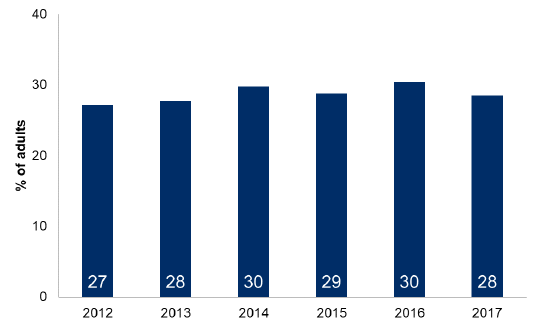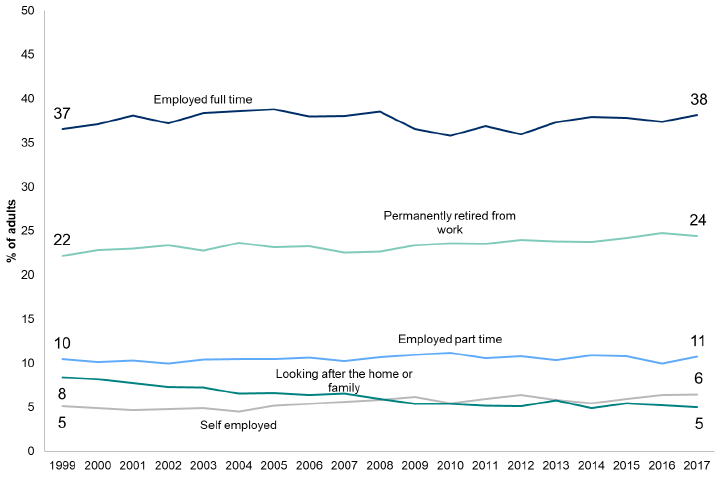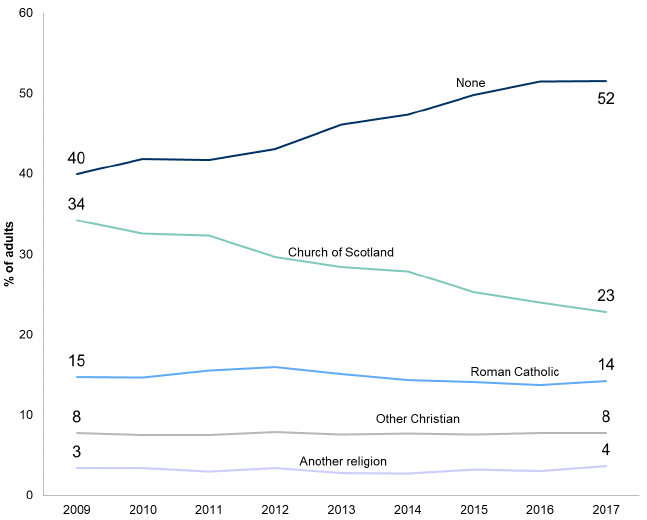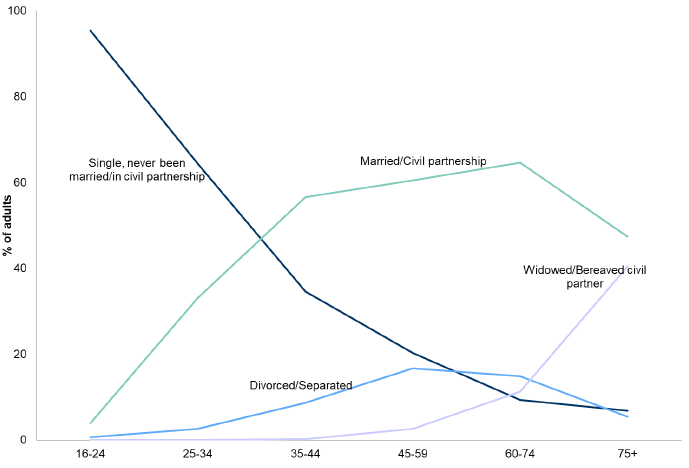Scottish household survey 2017: annual report
Results from the 2017 edition of the continuous survey based on a sample of the general population in private residences in Scotland.
2 The Composition and Characteristics of Households in Scotland
Main Findings
There were slightly more women than men in Scotland in 2017.
Twenty eight per cent of the population were under 25 years old while 24 per cent were 60 years or over in 2017.
In 2017, nearly three out of ten adults in Scotland reported having a long-term health condition, a similar proportion as in 2012.
The population in Scotland in 2017 is largely white, with nearly eight in ten adults (78 per cent) reporting having White Scottish ethnicity.
Nearly a quarter of all adults in Scotland were permanently retired from work. A half of adults aged between 16 and 64 years were working full time in 2017.
Since 2009, when this question started in the SHS, religious belonging in Scotland has been declining and this trend continued into 2017; a half of adults reported that they didn’t belong to any religion.
Over a third of people in Scotland live alone; 40 per cent of adults who live alone were of pensionable age in 2017.
In 2017, only five per cent of households in Scotland were two adult families with three or more children, or three or more adult families with one or more children.
Six out of ten households in Scotland were owner-occupied in 2017.
Scotland’s population in 2017 is largely urban-based, with over eight out of ten households in Scotland located in urban areas (including small towns) (84 per cent).
Just over a half (54 per cent) of households in Scotland earn less than £25,000 a year. Just over one in five (22 per cent) households earn more than £40,000 a year.
2.1 Introduction and Context
This chapter describes the types of homes in Scotland and who lives in them.
Collecting information on age, gender, disability, ethnicity, religion, and sexual orientation provides an important contribution to the overall equality evidence base. This is used by policy makers to target services and tackle discrimination and disadvantage. The Scottish Household Survey (SHS) collects information about all household members, including children.
The age and number of people in the household are combined to give a ‘household type’. The SHS uses eight household types defined as follows:
- A single adult household – contains one adult of working age and no children.
- A single parent household – contains one adult of any age and one or more children.
- A single older household - contains one adult of pensionable age and no children. Pensionable age is 65 for both women and men.
- A small family household – contains two adults of any age and one or two children.
- An older smaller household – contains one adult of working age and one of pensionable age and no children, or two adults of pensionable age and no children.
- A large adult household – contains three or more adults and no children.
- A small adult household – contains two adults of working age and no children.
- A large family household – contains two adults of any age and three or more children, or three or more adults of any age and one or more children.
2.2 All Household Members
The gender[15] and age of all household members as well as whether a household member has a long-term illness or disability[16] are presented in Table 2.1. This shows that there were more women than men in Scotland, 28 per cent of the population were under 25 years old while 24 per cent were 60 or over.
The highest income householder gives the characteristics of all household members, including children and answers questions on characteristics of the household. Due to the method of collecting this data, the household member characteristics of gender and age will be accurately reported. However, whether a member of the household has a long standing illness or disability is thought to be under reported as the household reference person may not know of individuals’ conditions.
Table 2.1: Characteristics of all household members
Column percentages, 2017 data
All household members
| Age | |
|---|---|
| 0-15 | 17 |
| 16-24 | 11 |
| 25-34 | 13 |
| 35-44 | 12 |
| 45-59 | 22 |
| 60-74 | 17 |
| 75+ | 8 |
| Total | 100 |
| Base | 23,080 |
| Gender | |
|---|---|
| Male | 49 |
| Female | 51 |
| Total | 100 |
| Base | 23,080 |
| Long-term physical or mental health condition | |
|---|---|
| Yes | 22 |
| No | 78 |
| Total | 100 |
| Base | 23,000 |
2.3 Adults in Private Households
Table 2.2 to Table 2. present equality characteristics of adults, based on those selected to take part in the interview. These tables provide estimates for age, gender, marital status, ethnicity, current economic situation of all adults and adults aged 16-64, whether adults have a long term illness or disability, and sexual orientation and religion of adults in Scotland.
Table 2.2 shows that there were more adult women than men in Scotland, 14 per cent of the adult population were under 25 years old while 30 per cent were 60 or over.
Table 2.2: Characteristics of adults – age, gender, and long-term health condition
Column percentages, 2017, Adults dataset
| Age | |
|---|---|
| 16-24 | 14 |
| 25-34 | 16 |
| 35-44 | 15 |
| 45-59 | 26 |
| 60-74 | 20 |
| 75+ | 10 |
| Total | 100 |
| Base | 9,810 |
| Gender | |
|---|---|
| Male | 48 |
| Female | 52 |
| Total | 100 |
| Base | 9,810 |
| Long-term physical or mental health condition | |
|---|---|
| Yes | 28 |
| No | 72 |
| Total | 100 |
| Base | 9,760 |
2.3.1 Long-term physical or mental health condition of adults
In 2017, over a quarter of adults (28 per cent) reported a long-term physical or mental health condition, a similar proportion as in 2012 (27 per cent), as shown in Figure 2.1.
Figure 2.1: Long-term physical or mental health condition of adults by year
2012 – 2017, Adults dataset (minimum base: 3,200)

2.3.2 Ethnicity
The population in Scotland is largely white, with nearly eight in ten adults identifying themselves as White Scottish. Table 2.3 shows a breakdown of the Scottish population by ethnicity.
Table 2.3: Characteristics of adults – ethnicity
Column percentages, Adults dataset
| Ethnicity | 2013 | 2017 |
|---|---|---|
| White | 96.4 | 95.6 |
| Scottish | 79.7 | 78.3 |
| Other British | 12.1 | 11.6 |
| Irish | 1.1 | 0.9 |
| Gypsy / Traveller | - | - |
| Polish | 1.2 | 2.0 |
| Other white ethnic group | 2.3 | 2.9 |
| Any mixed or multiple ethnic groups | 0.2 | 0.2 |
| Asian, Asian Scottish or Asian British | 2.2 | 2.6 |
| Pakistani, Pakistani Scottish or Pakistani British | 0.7 | 0.8 |
| Indian, Indian Scottish or Indian British | 0.7 | 0.8 |
| Bangladeshi, Bangladeshi Scottish or Bangladeshi British | 0.0 | 0.1 |
| Chinese, Chinese Scottish or Chinese British | 0.5 | 0.6 |
| Other Asian ethnic group | 0.3 | 0.3 |
| African | 0.4 | 0.5 |
| African, African Scottish or African British | 0.3 | 0.4 |
| Other African ethnic group | 0.1 | 0.1 |
| Caribbean or Black | 0.1 | 0.1 |
| Caribbean, Caribbean Scottish or Caribbean British | 0.0 | 0.0 |
| Black, Black Scottish or Black British | 0.0 | 0.0 |
| Other Caribbean or Black ethnic group | - | 0.0 |
| Other Ethnic Group | 0.7 | 0.9 |
| Arab, Arab Scottish or Arab British | 0.0 | 0.2 |
| Any other ethnic group | 0.6 | 0.8 |
| Don't know | - | - |
| Refused | 0.0 | 0.1 |
| Total | 100 | 100 |
| Base | 9,920 | 9,810 |
2.3.3 Economic status
Examining the economic status of all adults as well as a subset of adults aged 16-64 shows, in Table 2.4, that almost a quarter of all adults and five per cent of adults aged 16-64 are permanently retired from work. Only four per cent of adults aged 16-64 are unemployed and seeking work.
Examining the economic status over time, in Figure 2.2, shows that the proportion of those who were employed full time or self-employed has increased since 1999, while the proportion of those who worked part time has been stable. This also shows that the proportion of those who were permanently retired from work has increased since 1999, while the proportion of those looking after the home or family has decreased.
Table 2.4: Characteristics of adults – economic status
Column percentages, 2017, Adults dataset
| Economic status | All adults | Working-age adults |
|---|---|---|
| Self employed | 6 | 8 |
| Employed full time | 38 | 49 |
| Employed part time | 11 | 13 |
| Looking after the home or family | 5 | 6 |
| Permanently retired from work | 24 | 5 |
| Unemployed and seeking work | 3 | 4 |
| At school | 2 | 2 |
| In further / higher education | 5 | 7 |
| Gov't work or training scheme | 0 | 0 |
| Permanently sick or disabled | 4 | 5 |
| Unable to work because of short-term illness or injury | 0 | 1 |
| Other | 0 | 0 |
| Total | 100 | 100 |
| Base | 9,810 | 6,610 |
Figure 2.2: Economic status of adults by year – selected groups
1999 – 2017, Adults dataset (minimum base: 9,410)

2.3.4 Sexual orientation
Around two per cent of all adults self-identified as lesbian, gay or bisexual, as shown in Table 2.5. However, it should be noted that estimates on self-identified sexual orientation from the SHS are likely to under-represent the lesbian, gay and bisexual population. Potential reasons for this are discussed in Annex 2 Glossary.
Table 2.5: Characteristics of adults – sexual orientation
Column percentages, 2017, Adults dataset
| Sexual orientation | Male | Female | All |
|---|---|---|---|
| Heterosexual/Straight | 97.8 | 98.0 | 97.9 |
| Gay/Lesbian | 1.3 | 1.0 | 1.2 |
| Bisexual | 0.3 | 0.5 | 0.4 |
| Other | 0.0 | 0.1 | 0.1 |
| Refused | 0.6 | 0.4 | 0.5 |
| Total | 100 | 100 | 100 |
| Base | 4,540 | 5,270 | 9,810 |
2.3.5 Religion
Since 2009, when the harmonised question on religious belonging was introduced to the SHS, there has been an increase in the proportion of adults reporting not belonging to a religion, from 40 per cent in 2009 to just over a half of adults (52 per cent) in 2017 (Figure 2.3). There has also been a corresponding decrease in the proportion reporting belonging to ‘Church of Scotland’, from 34 per cent to 23 per cent.
Figure 2.3: Religious belonging of adults by year
2009 - 2017 data, Adults dataset (minimum base: 9,410)

2.3.6 Marital status
The proportion of adults who have never been married or in a civil partnership has increased from 34 per cent in 2013 to 36 per cent in 2017.
Table 2.6: Characteristics of adults – marital status
Column percentages, Adults dataset
| Marital status | 2013 | 2017 |
|---|---|---|
| Never married and never registered a same-sex civil partnership | 34 | 36 |
| Married | 48 | 47 |
| In a registered same-sex civil partnership | 0 | 0 |
| Separated, but still legally married | 2 | 2 |
| Separated, but still legally in a same-sex civil partnership | 1 | 0 |
| Divorced | 7 | 7 |
| Formerly in a same-sex civil partnership which is now legally dissolved | 0 | 0 |
| Widowed | 8 | 7 |
| Surviving partner from a same-sex civil partnership | 0 | 0 |
| Refused | 0 | 0 |
| Total | 100 | 100 |
| Base | 9,920 | 9,810 |
Figure 2.4: Current marital status of adults by age
2017 data, Adults dataset (minimum base: 650)

Exploring the marital status of different age groups reveals that single adults tend to be in the younger age groups. The proportion of those who are married or in civil partnership increases with age, similarly to the proportion of those who are divorced or separated (Table 2.7).
Table 2.7: Marital status and age of population
Row percentages, 2017, Adults dataset
| Marital status | 16-24 | 25-34 | 35-44 | 45-59 | 60-74 | 75+ | Total | Base |
|---|---|---|---|---|---|---|---|---|
| Single, never been married/in civil partnership | 36 | 29 | 14 | 14 | 5 | 2 | 100 | 3,130 |
| Married/Civil partnership | 1 | 11 | 18 | 33 | 28 | 10 | 100 | 4,070 |
| Divorced/Separated | 1 | 4 | 13 | 45 | 31 | 5 | 100 | 1,340 |
| Widowed/Bereaved civil partner | - | - | 0 | 10 | 33 | 57 | 100 | 1,280 |
| All | 14 | 16 | 15 | 26 | 20 | 10 | 100 | 9,810 |
2.4 Household Characteristics
The Scottish Household Survey provides estimates of geographical characteristics (Scottish Index of Multiple Deprivation and urban/rural classification), property type, household type, tenure and net household income[17] for households in Scotland.
Household type is derived from the details collected from the household respondent about all household members, using a combination of age and number of people in the household. Full definitions of each household type are included in Annex 2: Glossary. Combining the data in this way provides an indicator of the life stage and family circumstance of households. The Table 2.8 shows that:
2.4.1 Household type
- Over a third of people in Scotland live alone (35 per cent)
- Only five per cent of households in Scotland are two adult families with three or more children, or three or more adult families with one or more children
- Less than one in four of households in Scotland contain children
2.4.2 House type and tenure
- Around two thirds of households in Scotland live in a house or a bungalow with the remaining third living in a flat.
- Owner-occupier is the most common type of tenure with over six out of ten households living in a home they own outright or are buying, followed by a fifth in the social rented sector. Fifteen per cent of households are renting from a private landlord. More information on this is contained in Chapter 3 on housing.
2.4.3 Area type
- Over eight out of ten households in Scotland are located in urban areas (including small towns) (84 per cent), with only 16 per cent in rural areas.
2.4.4 Income
- Over a half of households in Scotland earn less than £25,000 a year (54 per cent)
- Just over one in five households earn more than £40,000 a year (22 per cent).
Table 2.8: The characteristics of households in Scotland
Column percentages, 2017, Households dataset
| Household Type | |
|---|---|
| Single adult | 20 |
| Small adult | 19 |
| Single parent | 5 |
| Small family | 13 |
| Large family | 5 |
| Large adult | 10 |
| Older smaller | 13 |
| Single older | 14 |
| Total | 100 |
| Base | 10,680 |
| Property Type | |
|---|---|
| A house or bungalow | 65.6 |
| A flat, maisonette or apartment (including four-in-a-block or conversion) | 33.9 |
| A room or rooms | 0.1 |
| A caravan, mobile home or a houseboat | 0.2 |
| Other | 0.3 |
| Total | 100 |
| Base | 10,680 |
| Tenure | |
|---|---|
| Owner occupied | 62 |
| Social rented | 22 |
| Private rented | 15 |
| Other | 1 |
| Total | 100 |
| Base | 10,680 |
| SIMD quintiles | |
|---|---|
| 1 - Most Deprived | 21 |
| 2 | 20 |
| 3 | 20 |
| 4 | 19 |
| 5 - Least Deprived | 20 |
| Total | 100 |
| Base | 10,680 |
| Urban/Rural classification | |
|---|---|
| Large urban areas | 35 |
| Other urban areas | 36 |
| Accessible small towns | 9 |
| Remote small towns | 4 |
| Accessible rural | 10 |
| Remote rural | 6 |
| Total | 100 |
| Base | 10,680 |
| Total household income | |
|---|---|
| £0 - £6,000 | 3 |
| £6,001 - £10,000 | 8 |
| £10,001 - £15,000 | 15 |
| £15,001 - £20,000 | 15 |
| £20,001 - £25,000 | 12 |
| £25,001 - £30,000 | 10 |
| £30,001 - £40,000 | 15 |
| £40,001+ | 22 |
| Total | 100 |
| Base | 10,300 |
Contact
There is a problem
Thanks for your feedback